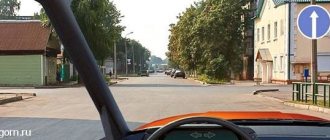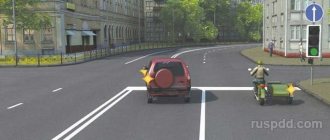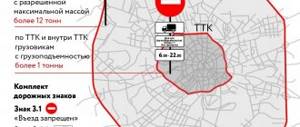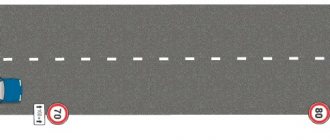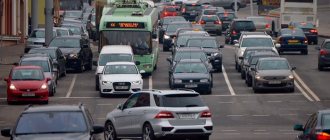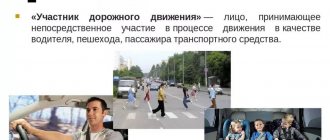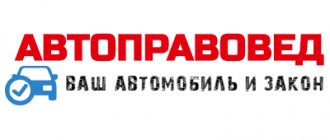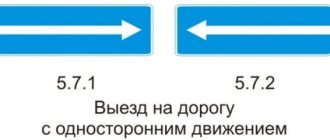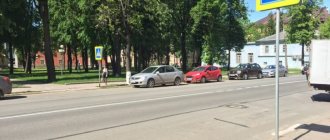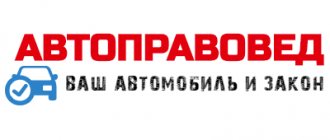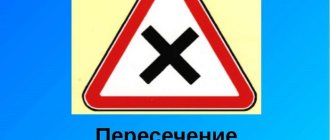The sign is prescriptive. These are the road signs that are collected in special section D of the Vienna Convention. The shape is round, the background is blue, the drawings themselves are white. The road sign tells you what vehicle drivers should do. It seems that its rule of use is quite simple, but experienced vehicle owners, as well as novice drivers, are aware of its pitfalls. If you do not know the clear purpose of the sign, you can break traffic rules and receive a fine.
Installation methods
The traffic sign is explicitly stated in several ways, which confuses its interpretation. The coverage area depends on how it is placed. That is, you need perfect knowledge of the rules in order to navigate in time.
The most famous location method is a place before a road intersection. And it’s immediately worth noting that the sign will be in effect in the area where it is located, not at the entire intersection.
Expert opinion
Artemyev Dmitry
Experience as a forensic expert in the field of automotive technical examination for more than 2 years, more than 3 years of work in the field of insurance disputes, appealing guilt in road accidents.
Ask a Question
If it is located near the road, then the effect of the sign extends to the part that the car crosses. When he is behind the intersection, then, according to traffic rules, you need to go straight to another intersection. It is allowed to turn right into the courtyard of a house, for example. But for drivers, especially beginners, it is difficult to navigate these rules. You need to know one clear rule: the sign prohibits turning left, and you can’t turn around either.
Purpose of sign 4.1.1
Sign 4.1.1
Many drivers in Russia do not understand why the sign 4.1.1 Drive straight is installed on the roads, and some simply ignore it, guided by their own experience. In fact, you may be fined for violating the requirements of the sign if the maneuver is recorded on a video camera or you are noticed by traffic police officers.
Besides the fine, there is one more problem. If you turn in a place where a straight ahead sign prohibits turning, you may end up on a narrow roadway with heavy traffic, that is, by your actions you will provoke an accident.
The need to make a left turn or a U-turn within the coverage area of sign 4.1.1 will also lead to a forced stop for vehicles following you on a narrow road. To avoid such congestion, sometimes a traffic sign is installed in the city: Go straight ahead.
In some cases, this sign allows a right turn, but many do not know in what cases such a maneuver is allowed or prohibited. For example, when driving under sign 4.1.1, it may be necessary to turn right into the yard or gas station. In this case, you do not need to let anyone pass to complete the maneuver, that is, you simply turn and do not interfere with anyone. However, not everything is as simple as it might seem at first glance. We will consider further special cases in which it is allowed and prohibited to turn right at the sign “Go straight ahead”.
Action
Inexperienced motorists do not quite understand why the traffic flow should be so restricted. And experienced drivers rely on their intuition, experience, and reaction speed. Of course, both categories are wrong. A fine for turning left is not just a monetary punishment. Most of the passages where these types of signs are installed are narrow. Moreover, they are burdened by heavy traffic. This means that there is a high probability that an accident will occur if the driver neglects the rules and starts moving to the left or turns around.
When a motorist stops to turn left, he automatically blocks other cars. In heavy traffic conditions, this is a problem. Because while a person is waiting for the opportunity to turn, the cars behind him are also waiting.
Important! Violating a traffic sign directly leads to the fact that not only the offender, but also innocent people can get into an accident. These signs are specially placed in very dangerous places.
Some people don’t quite understand why they can turn right but not left. This is explained quite simply. When the driver turns right, then, without interference, the driver calmly drives to where he needs to go. It does not stop the vehicle, does not force others to wait, that is, the flow of traffic is not blocked, as when turning left. In addition, there is no time spent waiting for the maneuver to take place.
Sign area 4.1.1
Many motorists who argue with traffic inspectors try to explain that they were oriented incorrectly and were unable to determine the coverage area of the installed sign. This shouldn't really be a problem since there aren't many options.
Coverage 4.1.1
When this road sign is placed in front of an intersection, its effect extends to a specific road intersection. If the sign is located outside the intersection on a straight section, it prohibits left turns and U-turns until the nearest intersection, after which the sign will no longer be valid.
There are no complex nuances in which you can get confused. You need to be especially careful when turning. If sign 4.1.1 is installed in front of the intersection, you should not turn around at it, not only because of the risk of getting a fine, but also to avoid creating an emergency situation.
Under the road sign Go straight ahead there may be a sign with a picture of a certain type of vehicle (for example, a heavy truck). Today people most often want to buy a MAN TGS. This is a universal transport solution that can be purchased at MAN Truck and Bus RUS. Accordingly, it is trucks that are covered by the sign, while drivers of passenger cars can make U-turns and turns without violating traffic rules.
What prohibits
Some motorists try to challenge the traffic inspector's decision if they are fined for improper driving. The main reason is that it is difficult for them to figure out which zone the sign applies to.
In most cases, there are no problems, since there are only two options:
- If the driver sees a warning sign immediately before an intersection, then the coverage area is limited to the intersection.
- If the sign is located in any other place, then we are talking about not turning left, and also not turning around. The rule is valid until the next intersection.
There are no other special clarifications on the effect of the sign. The driver should be extremely careful when making a U-turn. When you see a sign in front of an intersection, it is strictly prohibited to make a maneuver. It is allowed to turn left only after the intersection is already behind.
Expert opinion
Artemyev Dmitry
Experience as a forensic expert in the field of automotive technical examination for more than 2 years, more than 3 years of work in the field of insurance disputes, appealing guilt in road accidents.
Ask a Question
You also need to pay attention to additional elements near the road sign. Depending on the traffic flow, a sign may be attached and the corresponding vehicle drawn on it. This means that maneuvers of this vehicle are prohibited. For example, a truck is drawn, which means that it cannot turn around and turn left, but ordinary cars can.
What does a sign that says you can only go straight look like?
Mandatory road signs.
All mandatory road signs are described in Part 4 of Appendix 1 to the Traffic Regulations. The sign allowing the movement of vehicles only straight ahead has the number 4.1.1. This is a dark blue disk with a white arrow pointing upward drawn in the center.
The straight ahead sign is usually installed on narrow sections of the road with heavy traffic flow. It allows you to organize straight-line movement of vehicles, excluding left turns and U-turns in breaks in the dividing strip outside intersections.
Expert opinion
Sergey Aleksandrovich
An independent expert in the field of assessment after an accident, an experienced car lawyer.
Get free help!
. Dismiss
The disc allows you to turn right to enter a yard or other area adjacent to the road, for example, a gas station.
To understand the operation of the upward arrow disc and avoid penalties for not following its instructions, it is important to understand the logic behind the installation.
When a driver on a narrow road with heavy traffic wants to turn left or make a U-turn, he has to stop to wait for the opportunity to make a maneuver. Thus, the movement of cars behind him in the same lane is completely blocked.
When turning left or making a U-turn, the car will block the movement of traffic in the oncoming lane for some time. On busy sections of the highway, the indicated maneuvers are dangerous both for the driver performing them and for other motorists who did not have time to orient themselves in the current traffic situation in time.
By turning right from the far right lane, a motorist does not create obstacles for anyone to continue driving straight.
Are there exceptions possible?
The main use of this sign is to restrict turns after intersections. That is, drivers are given only one option - to go forward. But, as soon as the intersection is crossed, the sign’s coverage area ends. After this, the driver has the right to turn left or turn around.
If the road involves several intersections, then the sign is located immediately before the first and before the second intersection.
When a driver sees a sign not before an intersection, but on another section of the road, this means that the sign is valid until the driver passes the next intersection. It is worth noting that this sign does not apply directly to the intersection.
Important! You can turn right, but you cannot turn left, and you cannot turn the car around. Sometimes the sign is placed in front of the area where there is a break in the road separation strip.
It can duplicate continuous markings on the road, as well as double solid ones. This is done to make it easier for drivers to navigate during winter when visibility is difficult.
Attention! There is an exception to all these rules for route vehicles. They do not fall within the scope of the sign. These include all types of transport carriers of people. These are buses, trolleybuses, trams, minibuses. All those vehicles that have a route and passenger drop-off points.
Fines for driving under the Go straight ahead sign
Violation of traffic rules when making turns and u-turns threatens drivers with fines under Part 2 of Article 12.16 of the Administrative Code. The amount of the fine varies from 1000 to 1500 rubles. This wording in the Code of Administrative Offenses reads as follows: turning left or making a U-turn in violation of the requirements prescribed by road signs or markings of the roadway.
The sign is valid only for trucks
The driver can also be held accountable under Articles 12.13 and 12.14 of the Code of Administrative Offences, but we will look into this further. Article 12.13 describes penalties for violating the rules for driving through intersections. Entering or crossing an intersection during a traffic jam that forces the motorist to stop and create an obstacle for other vehicles moving in the transverse direction is subject to a fine of 1,000 rubles. This is exactly the traffic rule you can break by trying to make a turn or U-turn within the coverage area of sign 4.1.1.
Drivers often wonder what the fine is for turning left when there is a straight ahead sign? This violation is regulated by Article 12.16 of the Administrative Code and is punishable by a fine of 1000-1500 rubles.
If, together with sign 4.1.1, a turn or other maneuver is prohibited by road markings, the traffic police officer may classify the violation in different ways. In any case, the fine for crossing a solid road when turning is exactly the same - 1000-1500 rubles.
